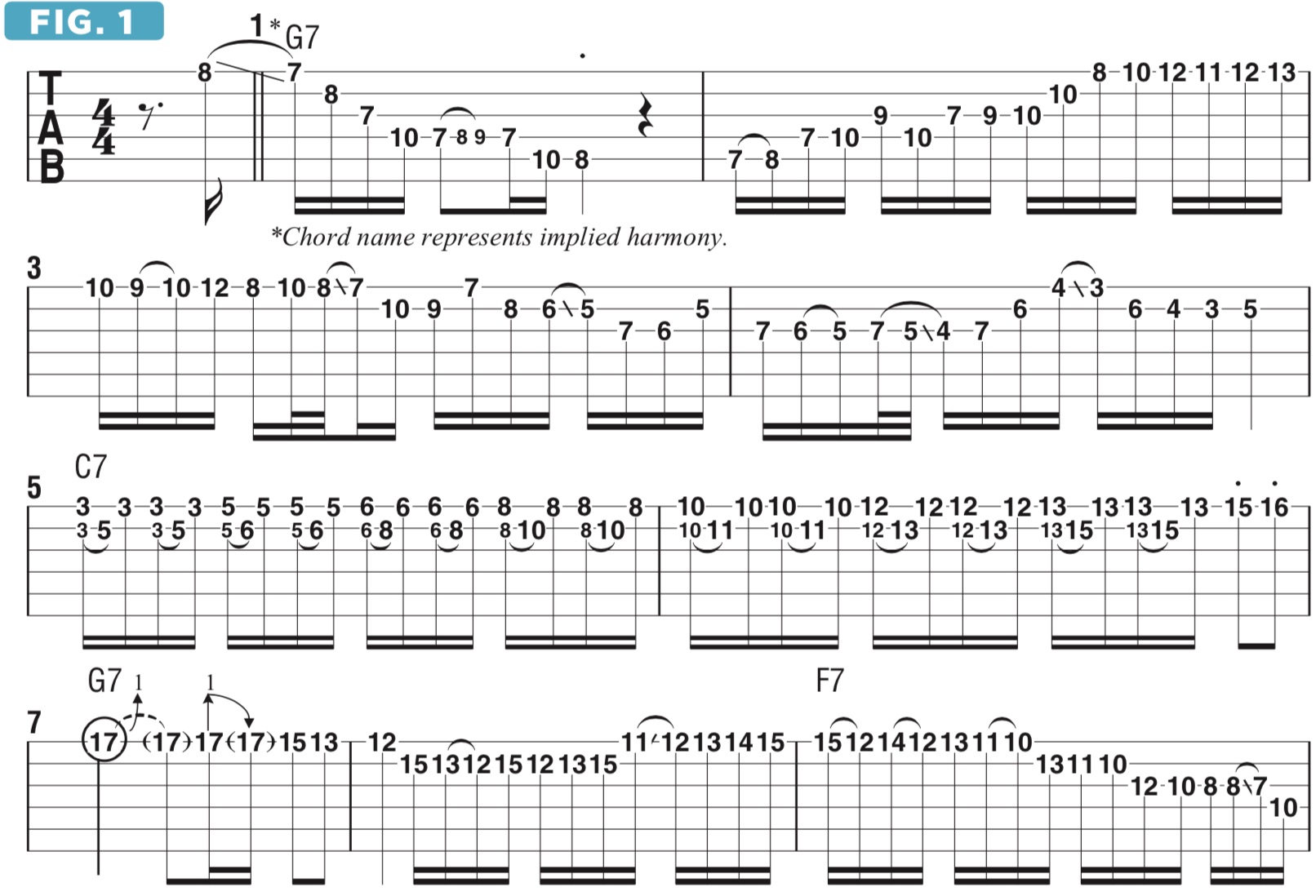Chromatic Arpeggios and Soloing on "Out of the Blue"
How arpeggios combined with chromaticism can expand the scope of your solos.
My last two columns have been dedicated to the track “Out of the Blue,” an original composition from my latest release, All Over the Place. Last month I discussed a few ways to approach soloing over the tune, and I’d like to continue on that tack this month by detailing a specific soloing concept that I often like to employ, which is the use of arpeggios combined with chromaticism (using notes a half step, or one fret, apart).
Like a standard blues form, the “Out of the Blue” solo section is 12 bars long, starting with four bars on the “one” chord, G7, followed by two bars on the “four” chord, C7 and then two more bars back on the one, G7. The twist comes in the last four bars, in that, in bars 9–11, I establish an Eb7-F7 alternating-chord sequence, followed in bar 12 with a single bar of the flat-two, or flat-nine, chord, Ab7.

FIGURE 1 represents an improvised solo over this 12-bar form. An arpeggio-based approach dominates bars 1 and 2, as I begin with a descending G7 arpeggio built from the notes B, G, D and F. In bar 2, I switch to Fmaj7 arpeggios by playing the notes F, A, C and E on beats one through three, but I bring in some chromaticism on beat four. In bars 3 and 4, I adapt to a more “horn-like” approach by sticking with lines based on a combination of the G Mixolydian mode (G A B C D E F) with ascending and descending chromatic “connection” figures.
At bar 5 through bar 6, over the four chord, C7, I use a favorite lick of mine, built from ascending thirds that are performed as double- stops on the top two strings with quick, grace-note hammer-ons on the lower B-string notes. I form each shape with an index-finger barre across the top two strings, and after strumming both strings, I immediately hammer onto the next higher note on the B string that falls within C Mixolydian (C D E F G A Bb).
On the return to G7 in bar 7, I play simpler, more blues-based lines followed by a scalar approach combined with chromaticism, again emphasizing a horn-like phrasing approach. Bars 9–11 are played over F7, and here I use the same notes of G Mixolydian, but because they are played over F7, they create the sound of F Lydian (F G A B C D E). Over Ab7, in bar12, I continue the Lydian approach with the use of Ab Lydian (Ab Bb C D Eb F G).

FIGURE 2 offers a more detailed look at the use of ascending and descending thirds performed as double-stops with grace-note hammer-ons. I adapted this approach from something I’ve heard pianists use in solos, but when applied to the guitar, it yields a very different sound.
This is the last installment of my All That Jazz column, so I hope the ideas and techniques I’ve presented here have been informative and useful. Keep jammin’!
Get The Pick Newsletter
All the latest guitar news, interviews, lessons, reviews, deals and more, direct to your inbox!
"Upgrading from your entry-level acoustic opens the door to an entirely new world of tonewoods, body shapes, and brands": 6 signs it's time to upgrade from your first acoustic guitar
"I'm past my prime": 5 common excuses for not learning the guitar – and 5 body and mind-boosting reasons you should










